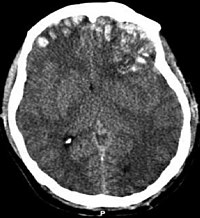
Photo from wikipedia
OBJECTIVES Traumatic brain injury in children is a leading cause of morbidity and mortality. Lack of high-quality evidence may lead to variation in management within and between PICUs. We examined… Click to show full abstract
OBJECTIVES Traumatic brain injury in children is a leading cause of morbidity and mortality. Lack of high-quality evidence may lead to variation in management within and between PICUs. We examined U.K. pediatric traumatic brain injury management guidelines for extent of variability. DESIGN Analysis of U.K. PICU traumatic brain injury guidelines for areas of consistency and variation among each other and against the second edition of Brain Trauma Foundation pediatric traumatic brain injury guidelines. SETTING Not applicable. SUBJECTS Not applicable. INTERVENTIONS Textual analysis of U.K. PICU guidelines. MEASUREMENTS AND MAIN RESULTS Twelve key clinical topics in three traumatic brain injury management domains were identified. We performed textual analysis of recommendations from anonymized local guidelines and compared them against each other and the Brain Trauma Foundation pediatric traumatic brain injury guidelines. Fifteen guidelines used by 16 of the 20 U.K. PICUs that manage traumatic brain injury were analyzed. Relatively better consistency was observed for intracranial pressure treatment thresholds (10/15), avoiding prophylactic hyperventilation (15/15), cerebrospinal fluid drainage (13/15), barbiturate (14/15), and decompressive craniectomy (12/15) for intracranial hypertension. There was less consistency in indications for intracranial pressure monitoring (3/15), cerebral perfusion pressure targets (2/15), target osmolarities (7/15), and hyperventilation for intracranial hypertension (2/15). Variability in choice and hierarchy of the interventions for intracranial hypertension were observed, albeit with some points of consistency. CONCLUSIONS Significant variability in pediatric traumatic brain injury management guidelines exists. Despite the heterogeneity, we have highlighted a few points of consistency within the key topic areas of pediatric traumatic brain injury management. We anticipate that this provides impetus for further work around standardization.
Journal Title: Pediatric Critical Care Medicine
Year Published: 2020
Link to full text (if available)
Share on Social Media: Sign Up to like & get
recommendations!